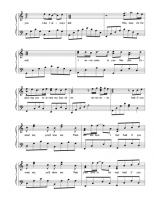

Vivaldi structured the Magnificat, RV 610, in nine movements, eight for the text of the canticle (Luke 1:46-55) and the conclusion for the doxology. Vivaldi wrote a later setting, RV 611, which retained the choral sections but replaced the three sections for solo voices by five more elaborate arias, in which individual girls from the orphanage could show off their skills.

While Vivaldi assigned two choirs, with instructions in the choral movements to use one or the other or both, it remains monochoral music. He revised it in the 1720s, making the tenor and bass parts more suitable to male voices, and adding two oboes, which he used prominently as obbligato instruments in an expanded version of "Sicut locutus est". 1715, and copied it for a Cistercian monastery of Osek soon afterwards. According to the musicologist Michael Talbot, Vivaldi wrote the earliest version in G minor for the orphanage c.

Musicologists differ in dating the works, for example before 1717 or in 1719. He composed settings of the Magnificat canticle, a regular part of vesper services.


 0 kommentar(er)
0 kommentar(er)
